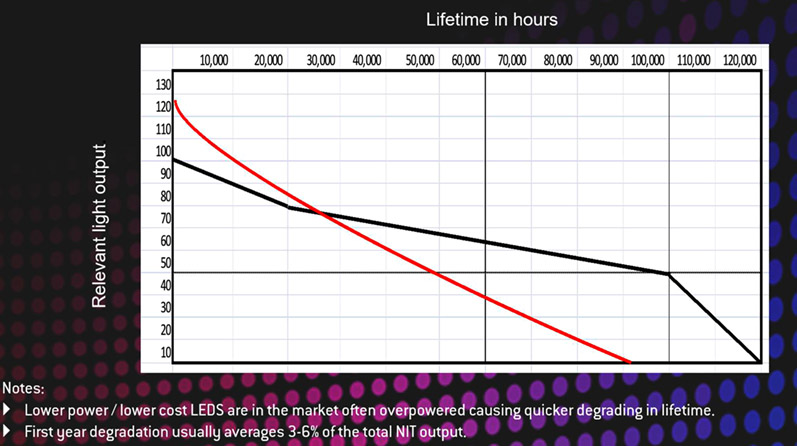To an average display buyer, and LED is an LED and that is where the understanding stops. However, as seen in the Blog 2 – “There’s gold in them there diodes…” Why? Published Feb 11/ 2020, LED are a complicated source of light with many intricate parts and precise ingredients that can ensure long life. However, not all display diodes are manufactured equally, with care, precaution, and proper quality control measures in place and this will lead to poor performance and shortened life.
LED Lifetime
Led lifetime is 100,000 hours, which represents a little bit more than a decade. To understand LED lifetime, certain parameters need to be met. In other words, the LED must be on 24 hours / 365 days per year at full forward voltage, or 100% of its current input to highest brightness (while showing full white color).
Relation between lifetime and the white color
Now no-one really leaves an LED display on for 100% of the time on full white content, but it is important to note that white is the hardest of all colors to recreate. Therefore, using more white content will degrade the LEDs faster. Considering this, it is important to use non-white backgrounds or reduce the amount of white used in content. This will assist in the contrast of the content and will help your LED display look shaper, longer and perform well though out the years to come. If not, degradation may set in and you will end up with patchwork or quilt work looking displays. This means that certain modules will degrade faster and become much more noticeable.
Maximizing the lifetime of your LED
There are means of rectifying an LED display that has patchworks or that is not looking as sharp as before. We must understand that these measures are only temporary in nature as degradation cannot be stopped.
• Reset and calibrate all power supplies within the displays.
One such culprit to degradation is not the module or LED itself but the failure and degradation of the power supplies being used. Proper calibration contributes in getting a better-looking display.
• Color Calibration
Back in the days, the system used for color calibration required hours and hours of darkness with specialized equipment to recalibrate a display. Now-a-days, all that is needed is a good quality Digital Single Lens Reflex (DSLR) camera which can be bought at any camera store or off of EBAY and decent calibration software and the process is done in under an hour.
When building an outdoor LED display, Nummax Display Innovation will use only LEDs with proven 100,000 hour lifetime which works out to be 11.57 years at 100% duty cycle. So, look to have a great looking display for about 10 years, and anything after that is simply gravy.


